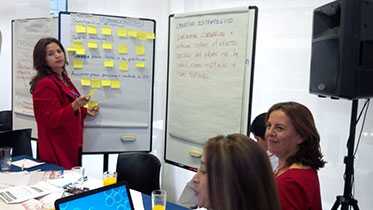NPHI Stories: Colombia: Balancing Risk and Reality to Protect Health
In the early days of an outbreak, communication is often the first and fastest public health tool available. But in emergencies, saying or doing something that upsets the public can accelerate misunderstanding as fast as a virus.
There is nothing quite like the spur of an escalating outbreak to focus a nation’s attention.
In the months between October 2014 and March 2015, Colombia went from no reported Zika cases to 25,000. Among these were nearly 3,000 pregnant women who had recovered from Zika, but who didn’t know whether their unborn children would be affected. And then, between early January and mid-February, people with Zika infection began coming to hospitals and clinics with unusually severe symptoms of a type of paralysis known as Guillain-Barré syndrome.

Colombian communication experts develop a risk communication plan template for environmental exposures, targeting the issue of lead exposure in the home.
Against this backdrop, Colombia’s National Public Health Institute, Instituto Nacional de Salud, called CDC to ask for help in risk communication training for their communication professionals, who must get information to the public during this critical time.
The right information at the right time
When outbreaks erupt, rumor and misinformation are frequently far ahead of public health interventions. Finding cases, gathering data, and understanding the effects of a disease can take days to months. In contrast, communication in today’s world is as fast as someone texting a friend. In quickly developing situations, it can be difficult to ensure people are getting the information they need to protect their health.
This is where risk communication becomes a core public health intervention. Risk communication aims to provide people affected by a public health event—whether an outbreak, a natural disaster, or an environmental exposure—with information that will help them make more informed decisions about their health and safety. Risk communication involves working with the people affected to understand both the kinds of information they need and the best ways to present that information to encourage them to adopt behaviors that will protect themselves and their families.
Training helps communicators
National public health institutes provide leadership and coordination for public health at the national level. They focus on the major public health problems affecting their countries, using scientific evidence to inform policies and allocate resources.
The risk communication training in Colombia and the resulting plans were part of the first year of CDC’s National Public Health Institute program’s support to Instituto Nacional de Salud, in partnership with the International Association of National Public Health Institutes (IANPHI). CDC and IANPHI help countries build the national capacity needed to respond decisively to public health threats such as Zika, influenza, tuberculosis, HIV-AIDS and non-communicable diseases.
CDC has logged 15 years of fine-tuning its use of risk communication during major public health emergencies. It was this experience that Spanish-speaking risk communication experts Jana Telfer and Óscar Tarragó brought to share in Colombia. In five 9-hour days, they introduced risk communication models and theory, how emotions affect understanding, and how to translate theory into practical, effective messages to help people protect themselves and their families. They also guided the Colombian communicators in developing risk communication plan templates for use in four types of public health emergencies.
“If we had had this information when we had a health crisis last fall, we would have handled it completely differently,” said one official.
By mid-afternoon on the first day, participants had divided into five groups dealing with four important national public health issues—so that their work over the next several days would be put to use immediately on current events. The day was scheduled to end at 6 PM, but teams stayed until after 7 PM in their enthusiasm to refine the first round of risk communication messages.
“I thought I already understood everything that was important to know about communication,” said one participant. “But I found that I still have much to learn.”
On the second day, the Colombian teams learned practical ways of analyzing communities and determining the best ways to bring perceptions into balance with the degree of danger. Before lunchtime they were applying that information to develop health messages for their issues.Over the next two days, they folded this work into national risk communication plans for Zika virus, HPV immunization, an environmental exposure and a natural disaster. Categories of public health emergencies very often call for particular concepts and methods; so the four completed plans can serve as templates for future events.
“We didn’t lose anyone during the week. Those who came at 9 o’clock on Monday morning were vigorously debating priorities at 5 o’clock on Thursday,” said Jana.
“Most significantly, our Colombian colleagues synthesized information very rapidly. The quality of their messages transformed over the course of these few days,” she said. “And the input they provided during the week helped us strengthen the course for the future.”
The CDC team is translating their training materials from Spanish into English so the training can be adapted for other countries.
About the International Association of Public Health Institutes
IANPHI is the only membership-based organization dedicated to strengthening national public health institutes. CDC and IANPHI work in partnership to provide national public health capacity in low-resource countries by providing direct funding to governments to develop national public health institutes (NPHIs). IANPHI provides grants funding to NPHIs to conduct peer-to-peer NPHI evaluation, establishment of new institutes, targeted assistance to boost capacity, and seed grants to support research agendas that support an institute’s capacity to carry out its public health mandate.
The IANPHI model allows countries to invest strategically in improvements—such as risk communication capacity-building—that have system-wide impact and potential for promoting further development.
- Page last reviewed: May 11, 2016
- Page last updated: May 11, 2016
- Content source:


 ShareCompartir
ShareCompartir